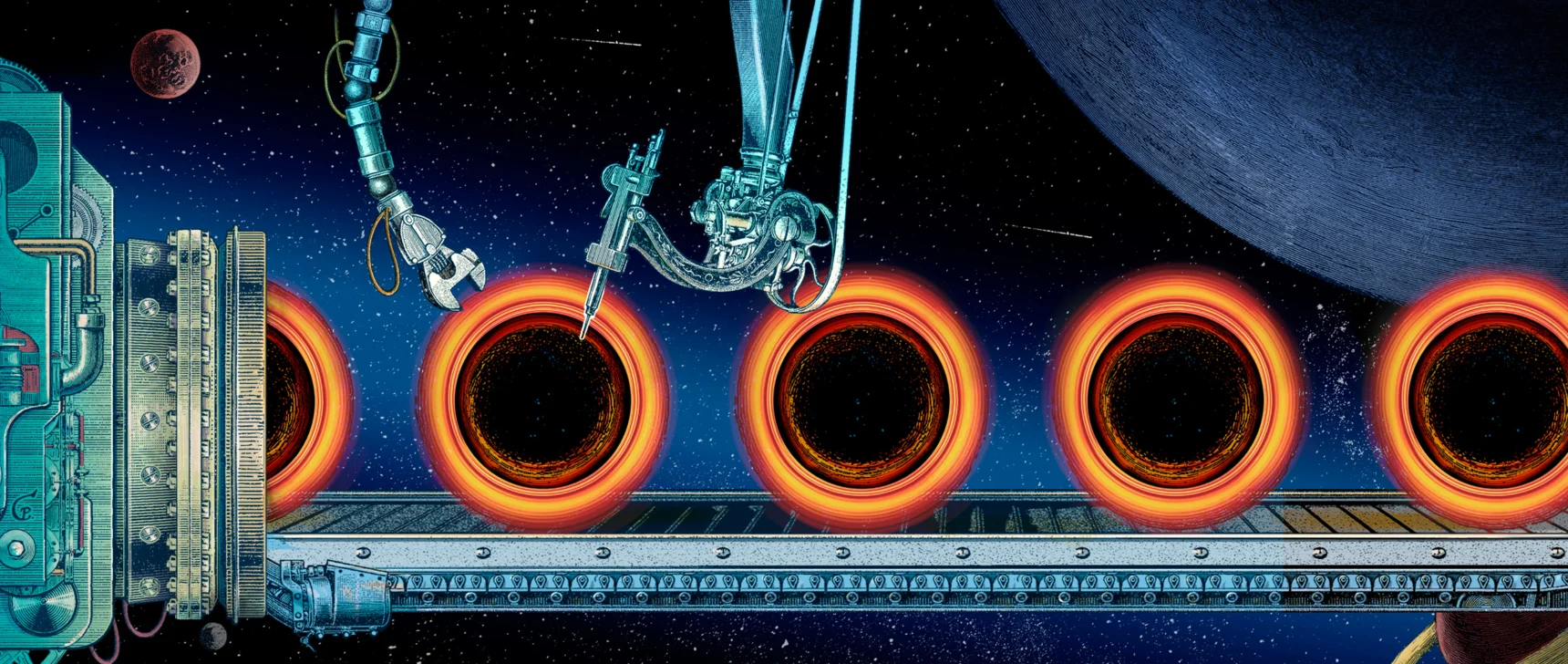The Sudden Surges That Forge Evolutionary Trees
Introduction
Over the last half-billion years, squid, octopuses and their kin have evolved much like a fireworks display, with long, anticipatory pauses interspersed with intense, explosive changes. The many-armed diversity of cephalopods is the result of the evolutionary rubber hitting the road right after lineages split into new species, and precious little of their evolution has been the slow accumulation of gradual change.
They aren’t alone. Sudden accelerations spring from the crooks of branches in evolutionary trees, across many scales of life — seemingly wherever there’s a branching system of inherited modifications — in a dynamic not examined in traditional evolutionary models.
That’s the perspective emerging from a new mathematical framework published in Proceedings of the Royal Society B that describes the pace of evolutionary change. The new model, part of a roughly 50-year-long reimagining of evolution’s tempo, is rooted in the concept of punctuated equilibrium, which was introduced by the paleontologists Niles Eldredge and Stephen Jay Gould in 1972.
“Species would just sit still in the fossil record for millions of years, and then all of a sudden — bang! — they would turn into something else,” explained Mark Pagel, an evolutionary biologist at the University of Reading in the United Kingdom.
Punctuated equilibrium was initially a controversial proposal. The theory diverged from the dominant, century-long view that evolution adhered to a slow, steady pace of Darwinian gradualism, in which species incrementally and almost imperceptibly developed into new ones. It opened the confounding possibility that there was a discontinuity between the selection processes behind the microevolutionary changes that occur within a population and those driving the long-term, broad-scale changes that take place higher than the species level, known as macroevolution.
In the decades since, researchers have continued to debate these views as they’ve gathered more data: Paleontologists have accumulated fossil datasets tracing macroevolutionary changes in ancient lineages, while molecular biologists have reconstructed microevolution on a more compressed timescale — in DNA and the proteins they encode.
Now there are enough datasets to more fully test the theories of evolutionary change. Recently, a team of scientists blended insights from several evolutionary models with new methods to build a mathematical framework that better captures real evolutionary processes. When the team applied their tools to a selection of evolutionary datasets (including their own data from research into an ancient protein family), they found that evolutionary spikes weren’t just common, but somewhat predictably clustered at the forks in the evolutionary tree.
Their model showed that proteins contort themselves into new iterations more rapidly around the time they diverge from each other. Human languages twist and recast themselves at the bifurcations in their own family tree. Cephalopods’ soft bodies sprout arms and bloom with suckers at these same splits.
The new study adds to previous support for the punctuated equilibrium phenomenon, said Pagel, who wasn’t involved in the project. However, the rapid evolutionary behavior isn’t a unique process separate from natural selection, as Eldredge and Gould suggested, but rather the result of periods of extremely rapid adaptation propelling evolutionary change.
“This is really a rather beautiful story in the philosophy of science,” Pagel said.
Phantom Bursts
Jordan Douglas, an evolutionary biologist at the Australian National University in Canberra, is fascinated by the origins of the genetic code. To understand those first stages of life’s evolution, he studies aminoacyl-tRNA synthetases (aaRSs), a family of enzymes essential to building proteins. The aaRS enzymes appear to predate the last universal common ancestor for all life on the planet.
“These enzymes are responsible for creating that kind of reflexive logic that nature uses to build itself, by helping to translate RNA into proteins which copy RNA, which build more proteins, which copy more RNA,” Douglas said.

Jordan Douglas, an evolutionary biologist at the Australian National University in Canberra, has developed a new mathematical framework with colleagues that shows the often-explosive pace of evolutionary change.
Marcelo Cortes
Douglas administers a growing database of aaRS structures and sequences from across the tree of life, which he and his colleagues use to reconstruct the protein family’s roughly 4-billion-year evolutionary history. Studying the sequences, he observed that these enzymes must have evolved in very fast bursts. Although the molecules are not species per se, they changed through time in a bifurcating treelike pattern, much like populations of organisms, as their new forms created branches with quasi-species. Their evolutionary tree pattern reminded Douglas, who did this research while working at the University of Auckland, and his colleagues of the debate about punctuated equilibrium.
The team went down a “rabbit hole,” Douglas said, to surface and assess any evidence in support of Eldredge and Gould’s theory — datasets on everything from the evolution of mammalian body size to Australasian parrots’ specialized digestive system for slurping nectar, to the early global spread of the virus behind the Covid-19 pandemic. They wanted to build a cohesive model of how punctuated equilibria take shape across many forms and scales of life, including and beyond enzymes. They were especially curious about those elusive moments where one species becomes two.
A key part of their approach introduced “spikes,” a model parameter that measures the amount of change that occurs every time a branch appears. “[The spike is] a novel contribution of this algorithm that is not usually done in phylogenetics,” Douglas said.
The paradigm in phylogenetics (the study of evolutionary relationships), he said, is that changes happen not only slowly and gradually, but often independently once a new species forms its own branch. The assumption was that when one species splits from another, the two new forms passively evolve away from each other, drifting solo on their evolutionary paths like two untethered buoys at sea. But Douglas doesn’t think this is how evolution always plays out in reality — he thinks there can be a split-and-hit-the-gas dynamic.
“When one group or population splits into two, it’s like there’s often this magnetic propulsion that immediately drives them apart,” Douglas said. “Then afterwards they go through a kind of slow, independent evolution.”
The new model also incorporates past branching events that we can’t see today. If a lineage branches, but that branch is cut short — sliced off millions of years ago when the lineage went extinct — then it may not appear at all in modern data. Douglas and his team accounted for what he called “phantom bursts” of evolution, termed “stubs” in their model. “Even though the branch is gone, it’s left behind a footprint,” Douglas said.
The approach builds on the insights of other evolutionary biologists, including Pagel, who in 2010 co-developed a method to account for lost branches of extinct species. Douglas’s team’s model is more general than previous approaches, Pagel said, allowing researchers to develop trees where the rate of evolution varies throughout. “There’s a lot of little bits of this story that come together in a really nice way,” he said.
Explanatory Power
Once the team developed their new model, they tested it on over a dozen evolutionary datasets across multiple fields of study.
When the researchers applied the model to their own research on aaRS enzymes they saw rapid changes accumulate around the branches of the evolutionary tree. When they compared their aaRS tree to others that assumed more gradual changes, they saw that the relationships between lineages were similar. However, the new model’s evolutionary spikes made the new trees 30% shorter with respect to gradual change, which suggested that less time had passed between the earliest ancestors and the tips of the branches, and that the enzymes had evolved more quickly.
Douglas and his colleagues also reanalyzed a dataset on cephalopod traits, such as the emergence of tentacles and evolution of body shapes, from 27 living species and 52 fossils. The results showed what the researchers describe as being a trivial contribution of gradual evolution toward the physical shape of cephalopods over some 500 million years, with 99% of the evolution occurring in spectacular bursts near the forking of branches.

The new mathematical model showed that evolutionary bursts led to the emergence of almost all characteristic cephalopod traits such as tentacles.
Jaap Bleijenberg/Alamy
This sudden acceleration when lineages split — termed “saltative branching” by Douglas and his colleagues — isn’t limited to the evolution of living things. They found that it also applies to systems that living things create. The team turned their model loose on the series of treelike modifications and convolutions in the Indo-European family of languages. By accounting for early bursts in language evolution, the team developed an time estimate for the family’s origins in Eurasia.
The lesson from these results, Douglas said, is that punctuated equilibria are “quite pervasive, quite general” across many different faces of evolution. “It’s difficult to build up a solid understanding of evolution without accounting for this process,” he said. Saltative branching may be fundamental across biological and cultural evolution.
The Test of Time
The study merges the long-standing, and often conflicting, perspectives of paleontologists and molecular biologists when it comes to the pacing of evolution. Paleontologists — who primarily work with long-term morphological data from fossils — more often encounter punctuated equilibria. “What paleontologists have been much less able to get at is the whole narrowing down that actually happens at speciation,” said Gene Hunt, an evolutionary paleontologist at the Smithsonian National Museum of Natural History who was not involved in the new research. The details surrounding species emergence are difficult to capture in the fossil record simply because the process happens so quickly, he said.
Meanwhile, the phenomenon is less defined in genetic and molecular data, which tends to reveal more subtle, incremental differences as species diverge. “[Molecular biologists] definitely expressed the perspective that Gould was wrong or he didn’t understand molecular data,” said April Wright, a statistical phylogeneticist at Southeastern Louisiana University who was not involved in the new research. “So it’s definitely interesting to see this pattern [of abrupt evolution] getting measured in molecular data.”
What conditions could change the evolutionary tempo where trees fork? After spending time in new surroundings or experiencing new evolutionary pressures, two groups of organisms may split apart physically and quickly accumulate differences. The same may occur when humans and their cultures or languages become isolated from an initial, larger group.
“Maybe they’re in a new environment. Maybe they’re just adapting different sets of cultural norms as they grow as a group,” Wright said. “That would make a lot of sense, that you would see that same signature of change cluster at the nodes.”
These evolutionary bursts could also be equated with splitting or speciation events. Pagel describes species mostly being held in a kind of temporary stasis. Every so often, that stability is perturbed by environmental changes, and populations quickly evolve new ways to survive, occupying a different niche in their ecosystem.
The framework needs to be tested further. Just over a dozen studies were used in evaluating the new model, Hunt said. But there are probably hundreds of paleontological datasets alone that could be analyzed by these new tools, plus more on molecular evolution. “There’s a huge amount of data sitting around that could be used for this,” he said. There’s no telling which of those tests could perturb this new saltative branching model into its next evolutionary spike.
Update: September 2, 2025
The story was updated to acknowledge that while, at the time of story publication, Jordan Douglas was employed by ANU Australia, the research was performed while he was based at the University of Auckland.



